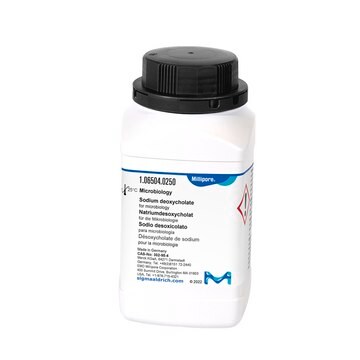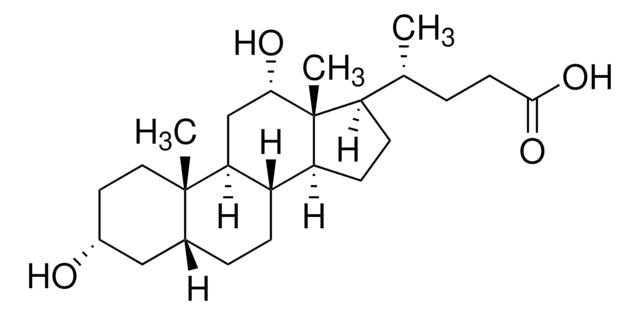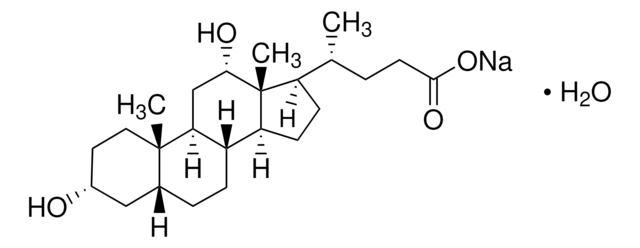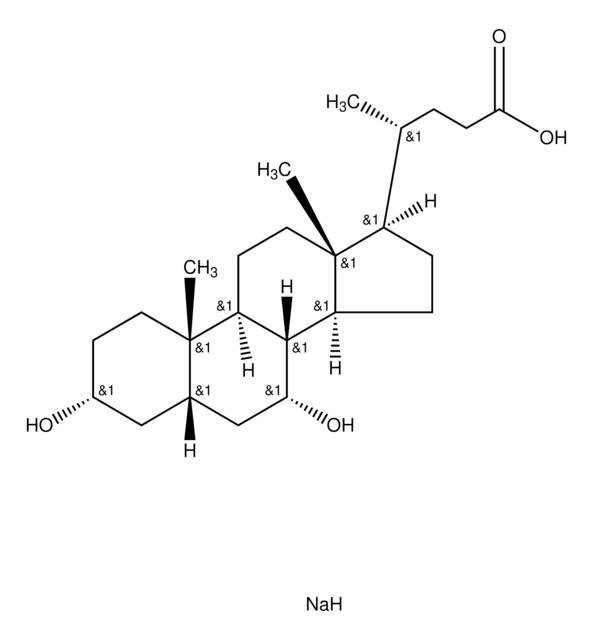D6750
Sodium deoxycholate
≥97% (titration)
Sinónimos:
3α,12α-Dihydroxy-5β-cholanic acid sodium salt, 7-Deoxycholic acid sodium salt, Desoxycholic acid sodium salt
About This Item
Productos recomendados
description
anionic
Quality Level
assay
≥97% (titration)
form
powder
mol wt
micellar avg mol wt 1200-5000
aggregation number
3-12
CMC
2-6 mM (20-25°C)
solubility
water: 50 mg/mL, clear, colorless to light yellow
HLB
16
functional group
carboxylic acid
shipped in
ambient
storage temp.
room temp
SMILES string
[Na+].[H][C@]12CC[C@@]3([H])[C@]4([H])CC[C@H]([C@H](C)CCC([O-])=O)[C@@]4(C)[C@@H](O)C[C@]3([H])[C@@]1(C)CC[C@@H](O)C2
InChI
1S/C24H40O4.Na/c1-14(4-9-22(27)28)18-7-8-19-17-6-5-15-12-16(25)10-11-23(15,2)20(17)13-21(26)24(18,19)3;/h14-21,25-26H,4-13H2,1-3H3,(H,27,28);/q;+1/p-1/t14-,15-,16-,17+,18-,19+,20+,21+,23+,24-;/m1./s1
InChI key
FHHPUSMSKHSNKW-SMOYURAASA-M
¿Está buscando productos similares? Visita Guía de comparación de productos
Categorías relacionadas
General description
Moreover, Sodium Deoxycholate extends its utility to nucleic acid extraction from cells and tissues. By lysing cells and disrupting cellular structures, it facilitates the release and purification of nucleic acids, proving valuable in cell biology and biochemical research. Beyond these applications, its effectiveness in cell lysis processes positions it as a valuable tool for breaking down cells and releasing their contents, finding applications in diverse biological studies, encompassing microscopy, cell biology, and biochemical research.
Application
Biochem/physiol Actions
Features and Benefits
Other Notes
Comparable product
Optional
also commonly purchased with this product
signalword
Warning
hcodes
Hazard Classifications
Acute Tox. 4 Oral
Storage Class
11 - Combustible Solids
wgk_germany
WGK 1
flash_point_f
Not applicable
flash_point_c
Not applicable
ppe
dust mask type N95 (US), Eyeshields, Gloves
Elija entre una de las versiones más recientes:
¿Ya tiene este producto?
Encuentre la documentación para los productos que ha comprado recientemente en la Biblioteca de documentos.
Los clientes también vieron
Artículos
Manufacturing, Characterization and Use of Single Walled Carbon Nanotubes
The liver excretes excess cholesterol in the form of bile acids. Bile acids serve two purposes: to remove unwanted cholesterol from the body and to aid in lipid digestion in the intestine.
Today, diverse studies report the benefits of probiotics, such as inhibitory effects on pathogens, aid in the management or prevention of chronic intestinal inflammatory diseases or atopic syndromes, and support to the immune system. Potential beneficial applications abound, researchers continue to evaluate the effictiveness and clarify the mechanisms of action of probiotics.
Protocolos
The dispersibility and bundle defoliation of single-walled carbon nanotubes (SWCNTs), which can be applied to materials produced by the CoMoCAT® process, have been extensively investigated by SouthWest NanoTechnologies (SWeNT ®) and at the University of Oklahoma.
Nuestro equipo de científicos tiene experiencia en todas las áreas de investigación: Ciencias de la vida, Ciencia de los materiales, Síntesis química, Cromatografía, Analítica y muchas otras.
Póngase en contacto con el Servicio técnico






